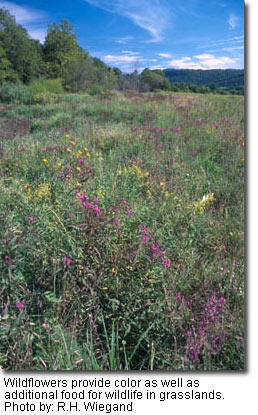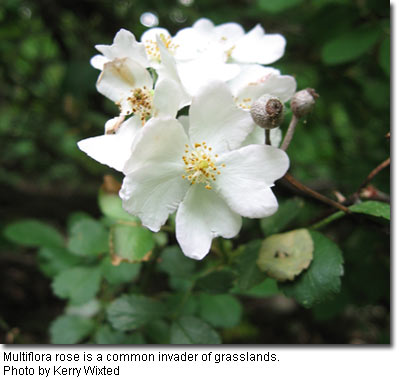Creating a Wild Backyard - Mowing Cycles for Wildlife
Mowing is often a boring chore, and people generally try to incorporate more gardens in their landscape to decrease the time required to mow their yard. While mowing can be burdensome, mowing in cycles can actually create diverse habitat for wildlife while also consuming less time.
To Mow or Not to Mow
In Maryland and many other surrounding states, grassland habitat has steadily declined. With this loss of habitat, many species which depend on grasslands for food, cover and breeding areas have also declined. This loss of grassland habitat is caused by both natural and anthropogenic (human-related) means. In nature, grasslands eventually are colonized by woody plants such as trees and shrubs. This gradual change in plant communities is known as succession. Succession is a dynamic process, and disturbance of any kind can reset succession. So, one of the easiest ways to maintain grassland habitat and to hold off succession is to mow.
Other benefits to mowing include suppressing noxious weeds like the invasive multiflora rose (Rosa multiflora) and stimulating the growth of
warm season grasses and wildflowers.
Before You Begin
First and foremost, bef ore you begin mowing cycles for wildlife, check with your community association and/or local ordinances concerning grassland habitat. You should adhere to all such ordinances and request exemptions in the manner recommended by the governing jurisdiction. As always, it is best to talk to your neighbors about your backyard wildlife habitat to educate them on Wild Acres before you start projects like mowing cycles.
ore you begin mowing cycles for wildlife, check with your community association and/or local ordinances concerning grassland habitat. You should adhere to all such ordinances and request exemptions in the manner recommended by the governing jurisdiction. As always, it is best to talk to your neighbors about your backyard wildlife habitat to educate them on Wild Acres before you start projects like mowing cycles.
Once you have checked into laws and/or gained permission, the next step is to determine your goals for your mowing cycle. Are you interested in attracting a particular species, or do you want to attract a diversity of critters? If you are looking into attracting a certain species, then you should examine habitat requirements for that species (preferred plants, nesting times, etc) as well as the feasibility that species is in your area.
The next step in the mowing process is to decide where you want to mow. Mowing cycles are best employed in larger areas of an acre or more. These areas can be along roadsides, in fallow fields, around ponds or in areas bordering cropland. If you have the time, then consider planting a
wildflower meadow or
warm season grasses in the area you are setting aside for cycled mowing. A mixture of warm season grasses with a few cool season grasses can also benefit wildlife. Keep in mind that mowing cycles generally are not feasible for small areas such as urban and suburban yards.
When to Mow
If you are using mowing cycles to promote wildlife usage on your property, then it is important to only mow outside of nesting and brooding seasons. Most wildlife species in Maryland nest and rear broods between April and mid-August, so it is best to mow during late winter or early fall. For some species, like rabbits, winter cutting should be done in January to early February.
Best Management Practices
The best mowing cycles for your property depend on the type of area you are working with and what wildlife you are interested in attracting. The following list goes over a few common areas and best management practices for them.
Fallow Fields & Grasslands
For larger areas, the best way to maximize wildlife usage is to mow in blocks using a three year rotation schedule. To begin, divide the area into three sections of blocks or strips. Be sure that the blocks or strips are at least 100 feet wide. Areas narrower than 100 feet do not provide adequate cover from predators. Mow one section the first year, another section the second year and the final section the third year. In the fourth year, repeat the rotation schedule.
This method of mowing allows for year-round cover for wildlife. If you notice woody species, particularly invasive ones like multiflora rose or autumn olive, encroaching in your mowed habitat, then you may want to mow the area more frequently or mechanically remove the invasive plants. Be sure to keep at least one section available for wildlife, though. If you are working with native grasses, particularly tall,
warm season grasses, then only mow to a height of ten inches. By cutting warm season grasses to a height less than ten inches, you can damage or kill the plants.
Roadsides, Ditches & Edges
Mowing along roadsides, ditches and edges should only occur once every two to three years. Similar to fallow fields, edges should only be mowed to a height of ten inches. The best time to mow these areas is in the late summer, after August 15th.
Keeping Noxious Plants in Check
Any type of disturbance, even mowing, can allow certain invasive plants to establish in your grassland. Invasive plants are non-native plants which crowd out or outcompete native species. Keep a sharp eye on your grassland and remove any invasive species as soon as you detect them. If left unmanaged, then these species can quickly take over, make the area unsuitable for wildlife and can be quite costly to control. If you see a particular plant becoming dominant in your grassland, then it might be good to take a sample to a local Cooperative Extension service or to someone who may be able to identify it. Some species that you may want to become familiar with are:
- Autumn olive and Russian olive (Elaeagnus umbellata, E. angustifolia)- shrubs
- Bush honeysuckle (Lonicera spp.)- shrubs
- Canada thistles (Cirsium arvense)- herb
- Chinese lespedeza (Lespedeza cuneata)- herb
- Johnsongrass (Sorghum halepense)- grass
- Multiflora rose (Rosa multiflora)- shrub
- Wild teasel (Dipsacus sylvestris)- herb
- Wineberry (Rubus phoenicolasius)- shrub
In some cases, shorter mowing cycles may discourage the growth of these species. However, in other cases, you may have to resort to spot controlling invasives with selective herbicides. Be sure to select herbicides fit for the job and be sure to strictly adhere to herbicide application instructions and laws regarding usage

Invite Wildlife into Your Backyard!
For more information, please contact:
Maryland Department of Natural Resources
Wildlife and Heritage Service
Tawes State Office Building, E-1
Annapolis MD 21401
410-260-8540
Toll-free in Maryland: 1-877-620-8DNR
[email protected]
Acknowledgements:
- Wildflowers provide color as well as additional food for wildlife in grasslands. Photo by: R.H. Wiegand
- Multiflora rose is a common invader of grasslands by: Kerry Wixted